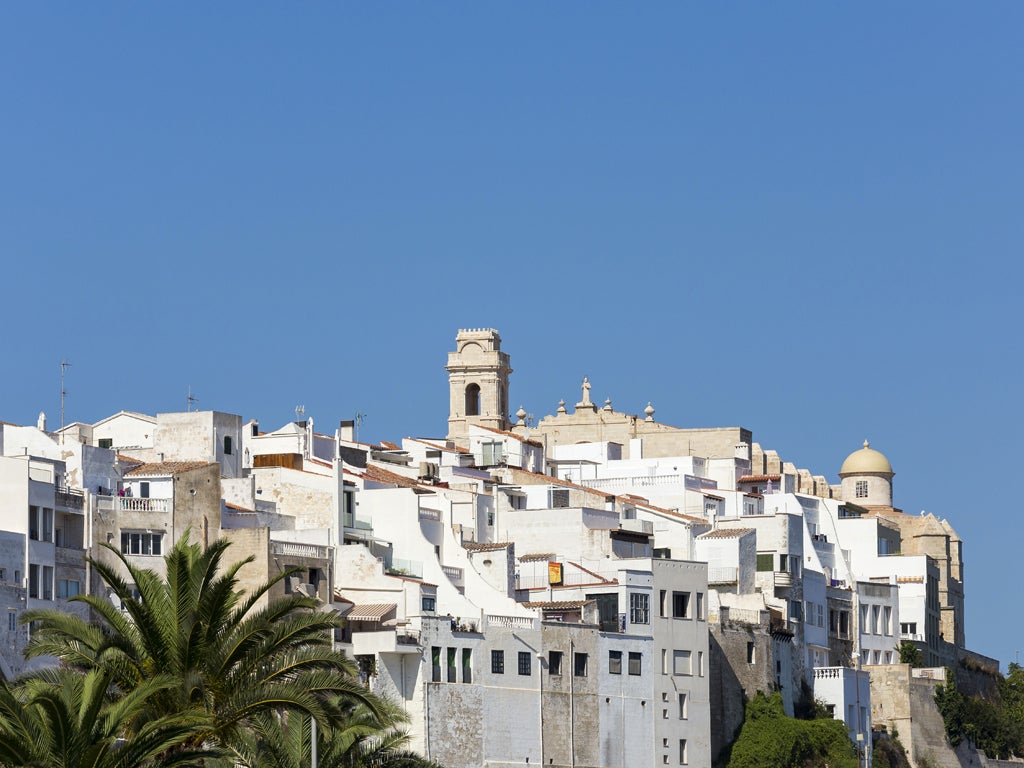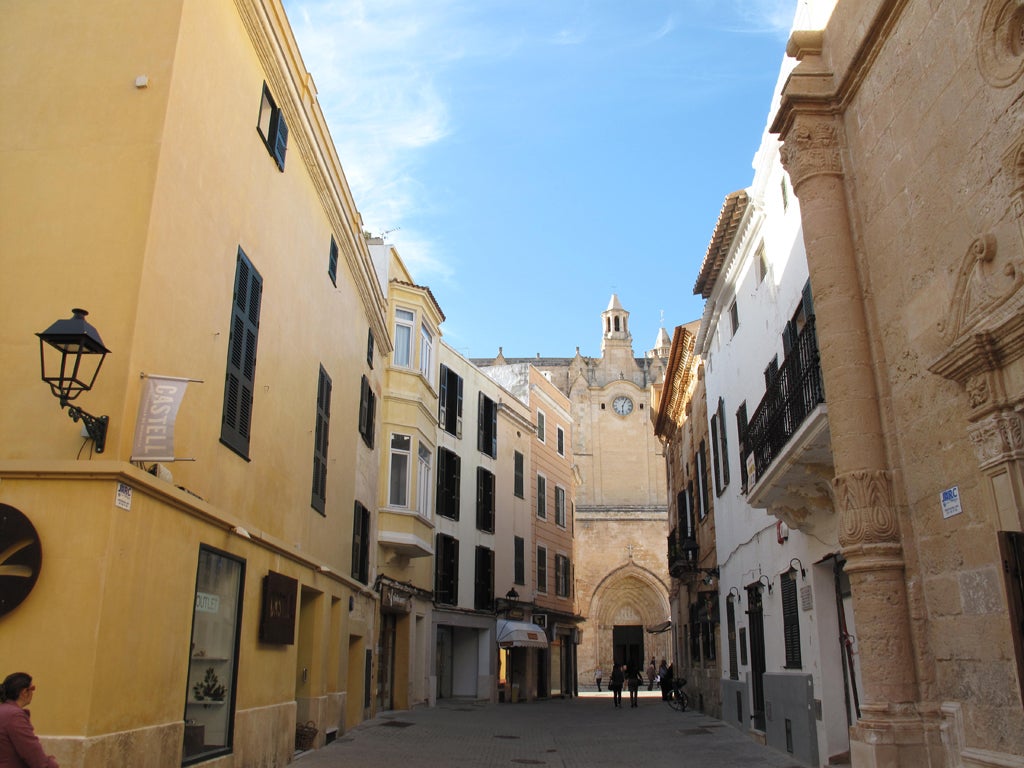Menorca travel tips: what to see and do in 48 hours
Watch the sun rise in Spain's most easterly isle, explore its modern and historic capital, then decamp to one of its beautiful beaches, says Simon Calder

Your support helps us to tell the story
From reproductive rights to climate change to Big Tech, The Independent is on the ground when the story is developing. Whether it's investigating the financials of Elon Musk's pro-Trump PAC or producing our latest documentary, 'The A Word', which shines a light on the American women fighting for reproductive rights, we know how important it is to parse out the facts from the messaging.
At such a critical moment in US history, we need reporters on the ground. Your donation allows us to keep sending journalists to speak to both sides of the story.
The Independent is trusted by Americans across the entire political spectrum. And unlike many other quality news outlets, we choose not to lock Americans out of our reporting and analysis with paywalls. We believe quality journalism should be available to everyone, paid for by those who can afford it.
Your support makes all the difference.Travel essentials
Why go now?
Spring is the time to discover this serene and fascinating island before the summer peak. The capital, Mahon (Maó), is a fascinating destination in its own right, with a glorious setting above the Mediterranean’s largest natural harbour. The location explains its rich history, from Bronze Age mystery to British Naval stronghold.
The island has been awarded Unesco Biosphere Reserve status, recognising and protecting its coastline, dune systems, wetlands and forests, which between them provide habitat for 220 species of birds and 1,000 species of plants.

Touch down
Over the next month the range of flights to Menorca will widen, with non-stop flights to the island’s airport (1) on British Airways (0344 493 0787; ba.com) from Heathrow; easyJet (0330 365 5000; easyJet.com) from Bristol, Gatwick, Liverpool, Luton and Southend; Jet2 (0800 408 1350; jet2.com) from Belfast, East Midlands, Edinburgh, Glasgow, Leeds/Bradford, Manchester and Newcastle; Monarch (0333 003 0700; monarch.co.uk) from Birmingham, Leeds/Bradford, Luton and Manchester; Ryanair (0871 246 0000; ryanair.com) from East Midlands; plus a range of links on the airlines of the two leading tour operators, Thomas Cook (0844 879 8880; flythomascook.com) and Thomson (0871 231 4787; thomson.co.uk).
The airport bus runs to Mahon’s main bus station at Placa de S’Esplanada (2) every hour (every half-hour from June to September), €2.50. A taxi to the centre costs about €10.

Get your bearings
Spain’s easternmost island is kidney-shaped and wrapped in a superb coastline. It is twice the size of the Isle of Wight, and rather sunnier. Mahon, at the eastern end of the island is balanced by the elegant former capital, Ciutadella (3), at the western end. They are linked by a good highway, the 45km ME1, from which roads run to the island’s resorts - most of them on the southern shore and ranging from low-key bays of hotels and apartments to wild, unspoilt coves with nothing more than white sand, pine trees and turquoise water.
Mahon has two tourist offices: one in the centre in the Town Hall on the Plaça de Constitució (4), the other down by the water at Moll de Llevant 2 (5). For more information call 00 34 971 363 790 or visit menorca.es.
Check in
Mahon makes an excellent base, partly due to its transport links and also because of its heritage and range of places to eat, drink and stay. The boutique hotel Jardí de Ses Bruixes (6) occupies a 200-year-old townhouse at Calle San Fernando 26 (00 34 971 363 166). Modernist flourishes from a makeover a century ago have been retained. The eight well-appointed rooms start at €120. Breakfast – served in a lovely courtyard – is extra, with three options: Menorca, Healthy and Continental.
(hotelsesbruixes.com)
Around the corner at Carrer d’Es Commerc 26 is the Hotel San Miguel (7) (00 34 971 364 059), whose Seventies look in the public areas is complemented by high-spec rooms. This cosy retreat offers double rooms and breakfast from €81.
(hotelsanmiguelmenorca.com)
A few miles east of Mahon on Carretera Sant Felip, the Hotel Rural Son Granot (8) (00 971 355 555) is a 300-year-old mansion built by the British. The Georgian treasure has rooms in the main house and also beautifully converted cottages in the grounds. Doubles start at €107 in April, including breakfast.
(songranot.com)
Day one
Take a view
Mahon perches on a bluff overlooking a harbour three miles long and half-a-mile wide, which means you can enjoy a succession of panoramas as you wander through the city. From west to east, the first mirador is outside the church of St Frances (9), at the west end of Calle Isabel II. Look back through the millennia in the Museu de Menorca, housed in the cloister adjoining the church (00 34 971 350 955; museudemenorca.com), covering the island’s early dominant cultures: Talayotic, Roman, Byzantine and Islamic. It opens 10am-2pm (to 6pm on Tuesdays and Thursdays, closed Monday), admission free.
Take a hike
Walk east from the church along Calle Isabel II. The street is flanked by 18th-century mansions, many with elegant bay windows from the period when the British ruled the island intermittently (1713-1802). The Gobierno Militar (10) is the former home of the governor. A few doors along, La Cereira (11) at Calle Isabel II 6 is a designer shop offering locally sourced and environmentally sensitive products. A few doors along on the same side of the street, look for a gate marked 2000, which should swing open to provide access for another excellent view.
Plaça de Constitució (4) contains the 1789 Ajuntament (town hall), with a clocktower donated by Sir Richard Kane - the first British Lieutenant-Governor of Menorca, who is still well respected. You can look along Sant Roc to the only remaining medieval gateway to the city.
Continuing east, Portal de Mar leads to the fish market (12), now with a range of eating and drinking options, and the Claustre de Carme (13) - the busy cloisters of the church of Carme.

Lunch on the run
The cloisters (13) now comprise the venue for the city’s produce market; you could assemble a picnic (augmented by the basement supermarket) or lunch in one of the cafes. Alternatively, at Portal del Mar 11, Can Pota (14) (00 34 971 36 23 63) has been serving local specialities including sobrasada – a Balearic pork speciality, like a spreadable chorizo – with potato and poached egg, for over a century.
Window shopping
The cloisters (13) have plenty of interesting stores, but the Saturday and Tuesday market at Placa S’Esplanada (2) is more vibrant. The local ironmonger, S’Esparter (15), on Carrer Sant Roc, has just celebrated 200 years of trading.
Cultural afternoon
As Mahon settles down for a siesta, catch bus 1 (taking an hour) or the express 14 (45 minutes) from Placa S’Esplanada (2) to Ciutadella (3). The former capital’s cobbled lanes and honey-toned houses comprise one of the loveliest old towns in Spain. The 14th- to 16th-century cathedral would provide a good reason to visit on its own, but there is plenty more – from the pretty harbour to the handsome Placa d’es Born.
An aperitif
Since Menorca is the first place in Spain to see the sunrise, it’s also the first place where you can legitimately sip a sundowner. Choose a cafe terrace on the Placa d’es Born, perhaps La Reina, and let the warm breeze waft scents of a sunny day over you while you drink in the Spanish and Moorish architecture.
Dine with the locals
Down by the waterside, the interior of the Café Balear (00 34 971 380 005; cafebalear.com) has been transformed into one of the most smartest restaurants in the Balearics - but there are also tables outside on the quayside where you can tuck into arroz caldoso - a rich and delicious seafood soup - in more informal surroundings.
The last bus 1 back to Mahon departs at 10.30pm from May to September.

Day two
Sunday morning: go to church
The ornate organ at Mahon’s Santa Maria church on Plaça de Constitució (4) is of bewildering proportions: 45ft high, and comprising 3,006 tubes. It was imported from Austria in 1810 on the orders of Admiral Collingwood, who ran Britain’s Mediterranean fleet from Mahon at the time. The church opens 7.30am-12.30pm each morning, with Mass at 11am each Sunday, and 5.30-8pm each evening.
Take a ride
From Placa S’Esplanada (2) take bus 32 (fare €2.55), which trundles every 90 minutes to the south coast resort of Son Bou (16) - one end of the longest beach in Menorca, stretching west for two miles. Follow the shore and dunes (possibly past some naked sunbathers, on what has become the island’s naturist beach) until you join the coastal path, known as the Cami de Cavalls - “Way of the Horses”. This ancient bridleway wraps its way around the island’s entire coastline. Follow it to Santo Tomas (17), which you should reach in an hour.
Out to brunch
The neighbouring resort of Sant Tomas (17) has plenty of refuelling options. But if you can make your way 12 miles across the island, via Es Mercadal, to the fishing port of Fornells (18) you will be rewarded with some astonishingly good seafood at the waterfront Es Port restaurant (00 34 971 376 403). Book in advance. Ask for what is good for the day, and you will be rewarded with a simply prepared but irresistibly tasty dish. Expect to pay around €25, excluding drinks. The restaurant is also one of several serving the local dish, caldereta de langosta, a lobster stew using local crustaceans that are in season from April-August. The limited availability comes with a price tag – expect to pay up to €130/kg.
A walk in the park
Menorca’s wild side, which Unesco rewarded with Biosphere Reserve status, is best represented at the beautiful lagoon of S’Albufera (19) - off the road from Fornells (18) back to Mahon. A network of paths helps you explore the natural beauty and extraordinarily rich wildlife.
The icing on the cake
The road from Mahon out to the airport (1) passes one of the island’s most impressive archaeological sites. The Talayotic era (derived from atalaya, Arabic for “watchtower”) between 1500 and 123BC saw the construction of dozens of cone-shaped structures across Menorca (although the earliest traces of human occupation on the island date from 2100BC).
Cornia Nou (20) is 300m west of the roundabout on the south-west side of Mahon. It includes a staircase that enables visitors to clamber to the top. While access is officially restricted to Saturdays, the gate is usually open.
Join our commenting forum
Join thought-provoking conversations, follow other Independent readers and see their replies
0Comments